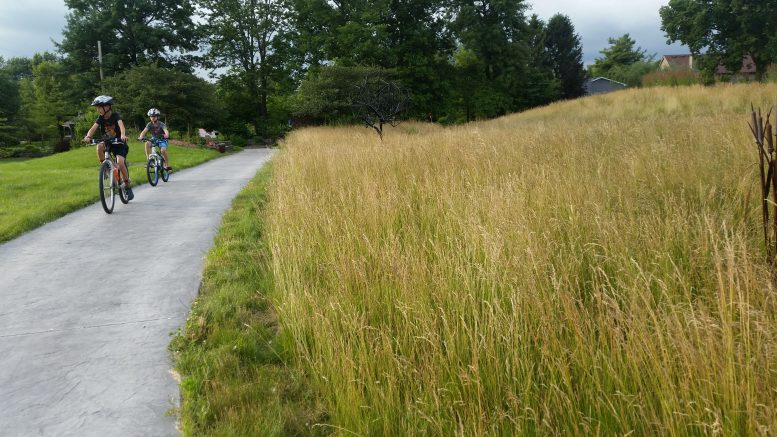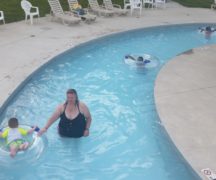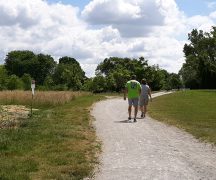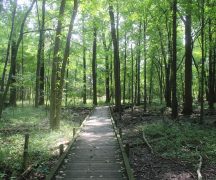By JAN LARSON McLAUGHLIN
BG Independent News
No, the city lawn mowers are working just fine. No, the recent rains haven’t created an abnormal growth spurt in these grasses.
The city parks and recreation staff is fielding questions about the new tall grasses being tried out in Simpson Garden Park.
To those with perfectly manicured lawns, the new experiment at Simpson Garden Park may be jarring and offend their sense of order. But to the park staff, the new tall grasses are an experiment that could lessen the human impact on the environment.
Chris Gajewicz, the city’s natural resources coordinator, talked about the new grass Tuesday evening during the monthly meeting of the city parks and recreation board.
The new grass getting the attention is a fescue called Scottish Links, growing near the amphitheater in the park. It is drought resistant, so it does not need to be irrigated, and does not need fertilized. Once established, the fescue out-competes weeds like dandelions and thistle, so there is little to no need for chemical herbicides and pesticides to manage weeds, Gajewicz said.
The Scottish Links is a low-mow grass variety, so the staff may mow it as little as once a year – which will use less fossil fuels and produce less carbon emissions. A sign will be posted by the fescue to explain its purpose.
Gajewicz realizes the tall grass may look unkept – particularly to people with perfect lawns. But this is an “experiment in sustainability” that can help reduce the city’s environmental footprint, he said.
Besides, some people appreciate a more natural look. “Beauty is in the eye of the beholder,” he said.
“Gardens are always in a state of change,” Gajewicz explained.
Since Simpson Garden Park was first created 13 years ago, it has undergone a lot of changes. The healing garden is now designed to nourish visitors’ minds, bodies and souls – instead of just displaying medicinal plants. New bridges and concrete paths have been installed to make the site accessible to people with physical disabilities.
And now the park staff wants to make the park more sustainable and responsible, he said.
The efforts were praised by Mayor Dick Edwards and City Council member Sandy Rowland.
“I so agree with what you’re doing,” Rowland said to Gajewicz. “I like your philosophy on this.”
Edwards said he appreciates the Scottish Links. “It’s a constant reminder to me what real golfers have to deal with.”
The mayor mentioned that his wife’s first reaction to the tall grass was not exactly positive. However, when the purpose for the fescue was explained, her opinion changed. “Even Nadine likes your Scottish Links,” Edwards said.
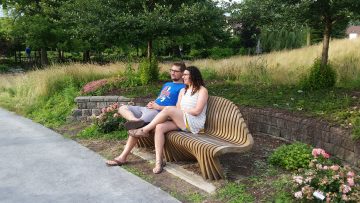
A couple sits on a bench by the tall grass.
To explain the unruly grasses to park patrons, Gajewicz wrote the following statement:
“Gardens, by definition, are not static but dynamic. They are living, growing, constantly evolving spaces. Each growing year, day, and even minute, every single moment in a garden is in a constant state of change. Visitors to Simpson Garden Park may have noticed over the past eleven years, the “Healing Garden” has changed to accommodate the entire person, their mind, body, and spirit while surrounded by healing plants. The garden is no longer a collection of medicinal plants, but a space meant to nourish the whole visitor. The Holistic Healing Garden is now a destination garden which is ADA compliant for disabled visitors. The concrete sculpted bridges, (and similarly themed benches), have been removed and replaced, again with ADA compliance in mind and also because the material with which they were constructed deteriorated over time. They had to be restored more than once by the only person who was capable, the original artist… at an additional cost we were not expecting. The new bridges are able to accommodate the donated golf cart which again, allows visitors with limited mobility the chance to visit all of the gardens while on a tour. The concrete paths are continually replacing crushed limestone paths for ease of access and again, ADA compliance. As with art, garden design is subjective to each individual’s tastes. Beauty is in the eye of the beholder. Each of us is drawn to a particular gardening design style. While some people prefer a more rigid approach to gardening, others are quite comfortable with what may appear to be a less managed look, something more natural in appearance. Each garden takes on its own personality which can appeal to a wider audience. Recently, one of the areas of Simpson Garden Park that was mowed turf grass in the past was allowed to grow to mature seed heads. The grass planted there is drought tolerant using less irrigation once established, little to no chemical herbicide and pesticide and no chemical fertilizers. The grass can be mowed once a week or it can be mowed once a month… even once a year. The Simpson Garden Park staff spends hundreds of hours and the department spends thousands of dollars each year managing the turf at this one park. To have a traditional American lawn, chemical treatments must be applied and irrigation incorporated. This grassy area which has been allowed to grow is an experiment in sustainability within a managed garden setting. Since the City of Bowling Green has recently hired its first ever Sustainability Director to manage sustainability activities in the city, our Parks and Recreation Department must also explore every opportunity we can to save water, eliminate two cycle engine exhaust whenever possible, limit the use of chemical herbicides and pesticides, and reduce our environmental footprint as a garden. I am constantly reminded by the many visitors to Simpson Garden Park that we have an amazing addition to this community. Ohio Magazine seems to agree, and they have placed Simpson on a statewide stage. The current staff of the Simpson Garden Park will continue to manage this space efficiently, responsibly, and aesthetically, with the hopes that our park visitors will continue to see the beauty throughout. We will continue to change and evolve each year with new plants, re-designed gardens, and new staff and volunteers who take the management of this space very seriously. We will continue to educate the public, the visitors, the neighbors and the community at large that the goal of Simpson Garden Park is not an end point but a journey.”
The park and rec board held its monthly meeting in the Girl Scout Building, which is one of the buildings to be demolished for the new building in City Park. Parks and Recreation Director Kristin Otley said efforts will be made to salvage some of the stones used to build the fireplace in the scout building.
Gajewicz said the stones probably predate the WPA wall surrounding City Park, since the building was constructed in the early 1900s as the Women’s Christian Temperance Meeting Hall.
Otley reported the design team for the new City Park building held its second meeting. Bids are expected to be taken in November, with the project to begin next March.
In other business:
- Ivan Kovacevic said the day camps offered by parks and rec are going very well, but the weekly lunches and concerts have been hit and miss with the weather.
- Gajewicz said the camps at Wintergarden Park are weather resistant. “Weather doesn’t make a difference for us,” he said. “They go out rain or shine.”
- Gajewicz said efforts are underway to get rid of poison ivy and invasive plant species in Wintergarden Park.
- Otley reported that the annual fundraiser for the Parks and Recreation Foundation will be held Sept. 28.

